Muscles in the Anterior Compartment of the Forearm
The muscles in the anterior compartment of the forearm are organized into three layers:
- Superficial: flexor carpi ulnaris, palmaris longus, flexor carpi radialis, pronator teres.
- Intermediate: flexor digitorum superficialis.
- Deep: flexor pollicis longus, flexor digitorum profundus and pronator quadratus.
This muscle group is associated with pronation of the forearm, flexion of the wrist, and flexion of the fingers.
They are mostly innervated by the median nerve (except for the flexor carpi ulnaris and medial half of flexor digitorum profundus, which are innervated by the ulnar nerve), and they receive arterial supply from the ulnar artery and radial artery
In this article, we shall look at the anatomy of the muscles in the anterior compartment of the forearm – their attachments, actions, innervation, and clinical correlations.
Superficial Compartment
The superficial muscles in the anterior compartment are the flexor carpi ulnaris, palmaris longus, flexor carpi radialis, and pronator teres.
They all originate from a common tendon, which arises from the medial epicondyle of the humerus.
Flexor Carpi Ulnaris
- Attachments:
- The flexor carpi ulnaris has two origins. The humeral head originates from the medial epicondyle of the humerus with the other superficial flexors, whilst the ulnar head originates from the olecranon of the ulna.
- The muscle tendon passes into the wrist and attaches to the pisiform bone, the hook of hamate, and the base of the 5th metacarpal
- Actions: Flexion and adduction at the wrist.
- Innervation: Ulnar nerve.
Palmaris Longus
This muscle is absent in about 15% of the population.
- Attachments: Originates from the medial epicondyle, and attaches to the flexor retinaculum of the wrist.
- Actions: Flexion at the wrist.
- Innervation: Median nerve.
Flexor Carpi Radialis
- Attachments: Originates from the medial epicondyle, and attaches to the base of metacarpals II and III.
- Actions: Flexion and abduction at the wrist.
- Innervation: Median nerve.
Pronator Teres
The lateral border of the pronator teres forms the medial border of the cubital fossa, an anatomical triangle located over the elbow.
- Attachments: It has two origins, one from the medial epicondyle, and the other from the coronoid process of the ulna. It attaches laterally to the mid-shaft of the radius.
- Actions: Pronation of the forearm.
- Innervation: Median nerve.
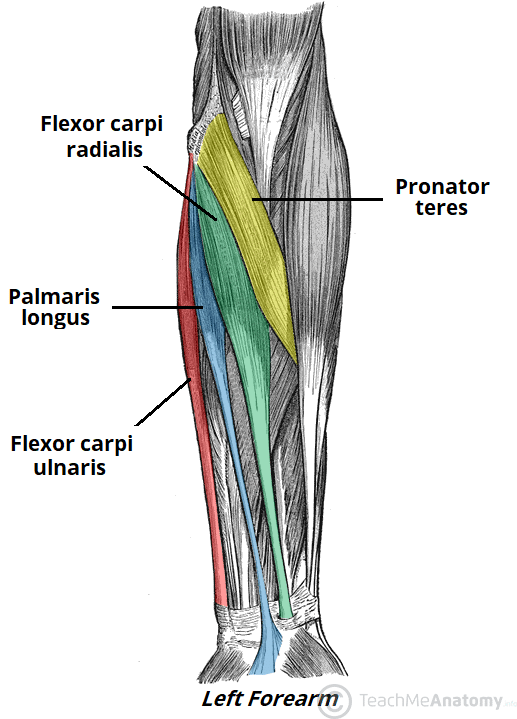
Fig 1 – The superficial muscles of the anterior forearm.
Intermediate Compartment
The flexor digitorum superficialis is the only muscle of the intermediate compartment. It can sometimes be classed as a superficial muscle, but in most individuals, it lies between the deep and superficial muscle layers.
The muscle is a good anatomical landmark in the forearm – the median nerve and ulnar artery pass between its two heads, and then travel posteriorly.
- Attachments: It has two heads – one originates from the medial epicondyle of the humerus, the other from the radius. The muscle splits into four tendons at the wrist, which travel through the carpal tunnel and attaches to the base of the middle phalanx of the four digits.
- Actions: Flexes the metacarpophalangeal joints and proximal interphalangeal joints at the 4 fingers, and flexes at the wrist.
- Innervation: Median nerve.
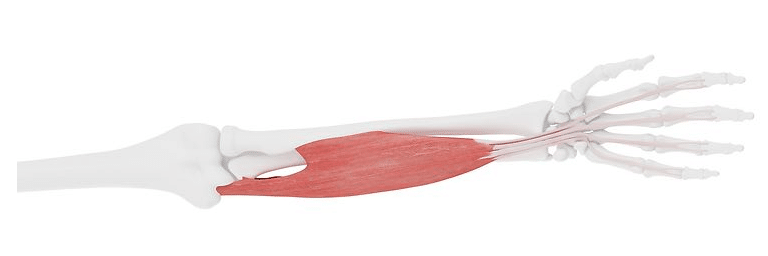
Fig 2 – Flexor digitorum superficialis. It has two heads, which arise from the medial epicondyle of the humerus and the shaft of the radius.
Deep Compartment
There are three muscles in the deep anterior forearm: flexor digitorum profundus, flexor Pollicis Longus, and pronator quadratus.
Flexor Digitorum Profundus
- Attachments: Originates from the ulna and associated interosseous membrane. At the wrist, it splits into four tendons, that pass through the carpal tunnel and attach to the distal phalanges of the four fingers.
- Actions: It is the only muscle that can flex the distal interphalangeal joints of the fingers. It also flexes at the metacarpophalangeal joints and at the wrist.
- Innervation: The medial half (acts on the little and ring fingers) is innervated by the ulnar nerve. The lateral half (acts on the middle and index fingers) is innervated by the anterior interosseous branch of the median nerve.
Flexor Pollicis Longus
This muscle lies laterally to the flexor digitorum profundus
- Attachments: Originates from the anterior surface of the radius and surrounding interosseous membrane. Attaches to the base of the distal phalanx of the thumb.
- Actions: Flexes the interphalangeal joint and metacarpophalangeal joint of the thumb.
- Innervation: Median nerve (anterior interosseous branch).
Pronator Quadratus
A square-shaped muscle found deep in the tendons of the flexor digitorum profundus and flexor Pollicis Longus.
- Attachments: Originates from the anterior surface of the ulna and attaches to the anterior surface of the radius.
- Actions: Pronates the forearm.
- Innervation: Median nerve (anterior interosseous branch).
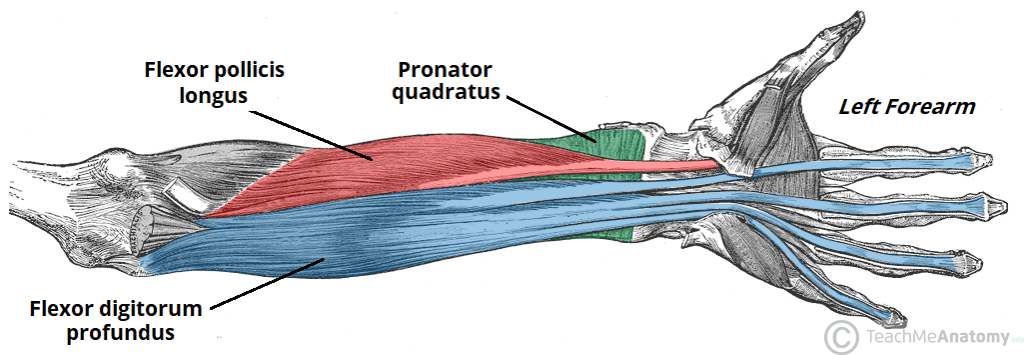
Fig 3 – Deep flexor muscles of the anterior forearm.
Prosection Images
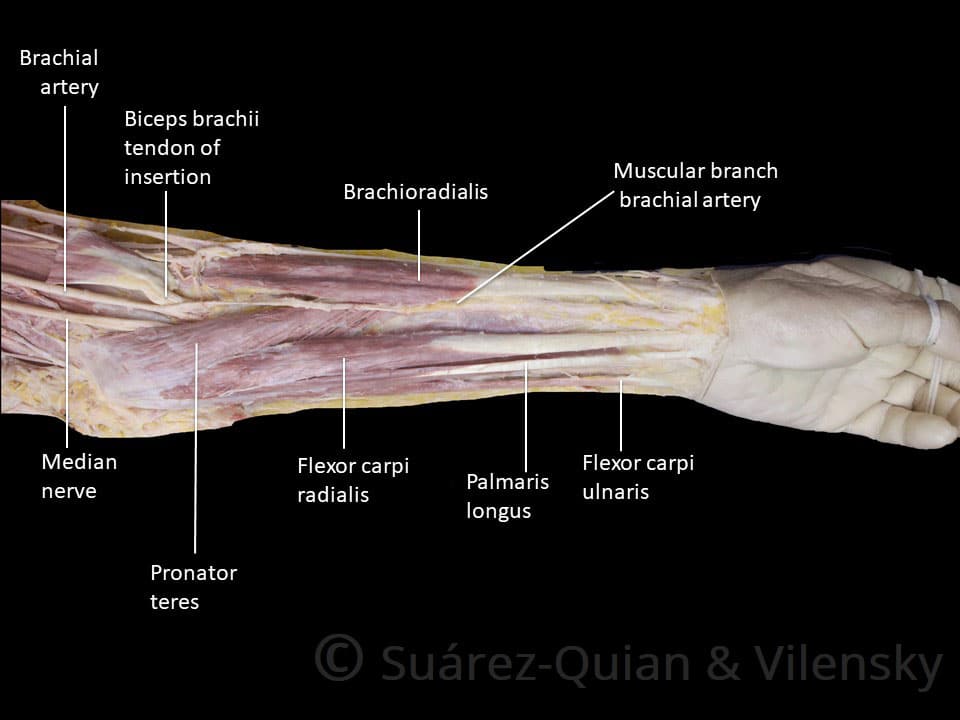
Prosection 1- The superficial layer of the anterior forearm.
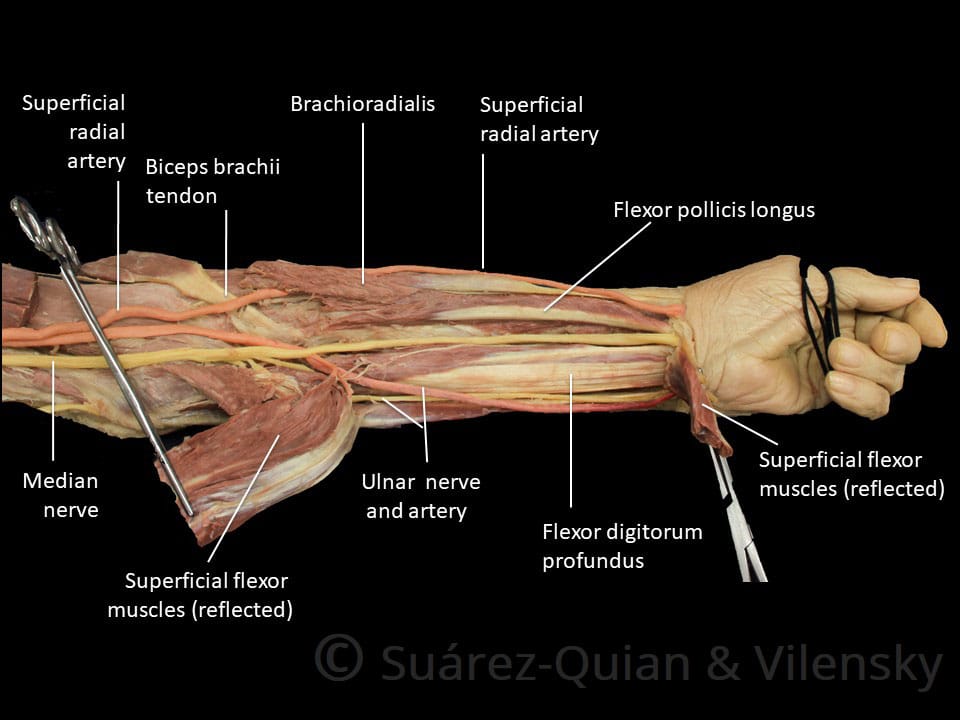
Prosection 2 – The intermediate layer of the anterior forearm
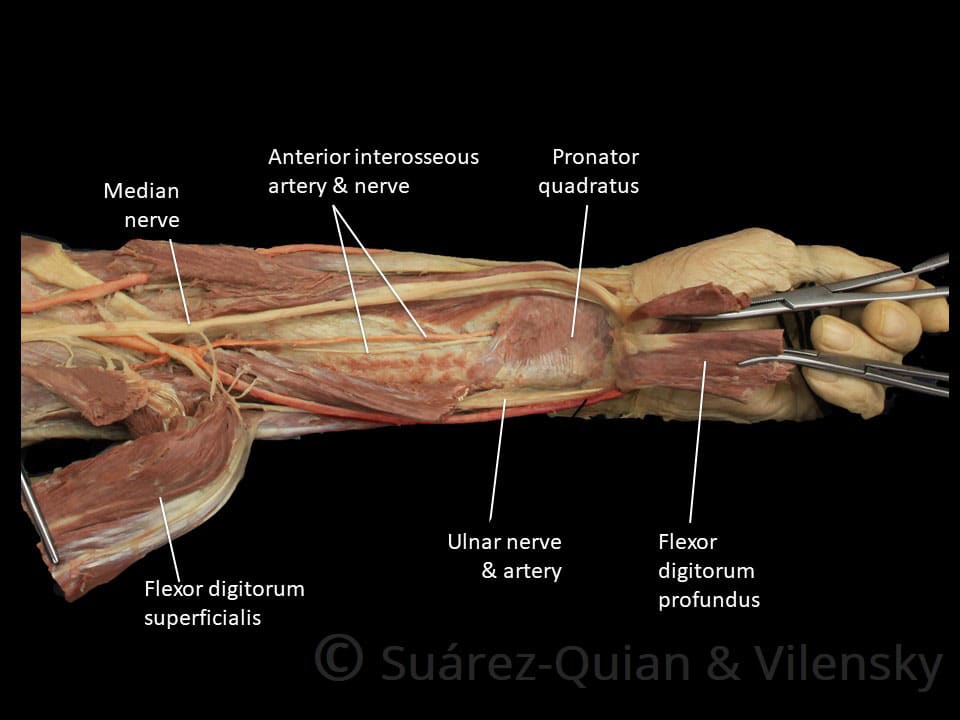
Prosection 3 – The deep layer of the anterior forearm.
The article was originally published here.

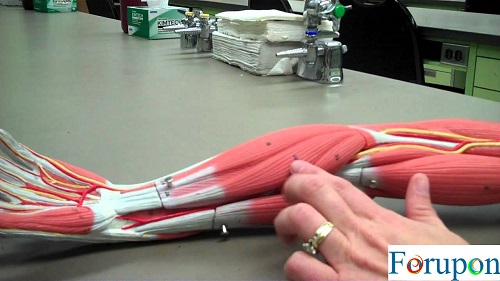
Comments are closed.